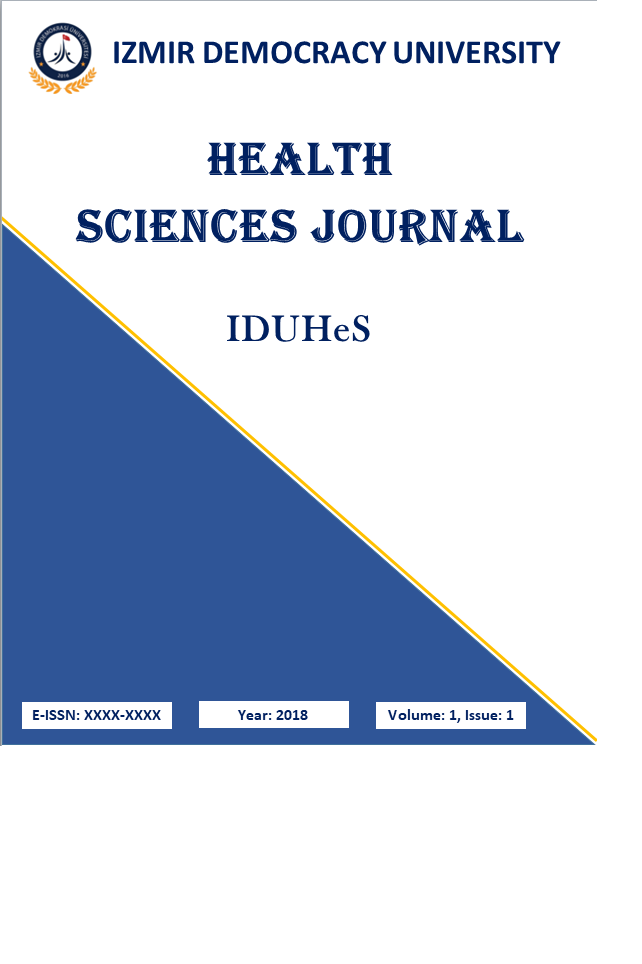VALIDITY AND RELIABILITY OF THE TURKISH VERSION OF THE NURSES’ ASSESSMENT OF QUALITY SCALE – ACUTE CARE VERSION: A METHODOLOGICAL STUDY
Nurse, Care, Quality, Validity-Reliability
VALIDITY AND RELIABILITY OF THE TURKISH VERSION OF THE NURSES’ ASSESSMENT OF QUALITY SCALE – ACUTE CARE VERSION: A METHODOLOGICAL STUDY
nurse, care, quality, validity-reliability,
___
- Akbas, M. (2019). Patient satisfaction on nursing care: the case of gynecology and obstetrics clinics. Acta bioethica, 25(1), 127-136. http://dx.doi.org/10.4067/S1726-569X2019000100127
- Alpar, C. (2016). Applied statistics and validity and reliability with examples from sports, health and education sciences. Ankara: Detail Publishing.
- Blasdell, N.D. (2017). The meaning of caring in nursing practice. Int J Nurs Clin Pract, 4(238), 1-5. https://doi.org/10.15344/2394-4978/2017/238
- Burhans, L.M., & Alligood, M.R. (2010). Quality nursing care in the words of nurses. Journal of advanced nursing, 66(8), 1689-1697.
- Capık, C. (2016). Use of confıdentıal factor analysıs ın valıdıty and relıabılıty studıes. Anatolian Journal of Nursing and Health Sciences, 17(3):196-205.
- Celik H. E., & Yilmaz V (2016). Structural Equation Modeling. 3rd Ed. Ankara, Turkey: Anı Publishing, 23-51.
- Church, C.D. (2016). Defining competence in nursing and its relevance to quality care. Journal for Nurses in Professional Development, 32(5), E9-E14. doi: 10.1097/NND.0000000000000289
- Costello, M. (2017). Nurses’ Self-Identified Characteristics and Behaviors Contributing to Patients’ Positive Perceptions of Their Nursing Care: A Qualitative Study. Journal of Holistic Nursing, 35(1), 62-66. 10.1177/0898010116643835
- Gul, S. (2019). Nursıng care ın the lıght of care concept and affectıng factors. ACU Sağlık Bil Derg, 10(2), 129-134. https://doi.org/10.31067/0.2019.134
- Karaca, A., & Durna, Z. (2018). Nursing Care Quality and Associated Factors. Health and Society, 28(3), 16-23.
- Kol, E., Geckil, E., Arıkan, C., Ilter, M., Ozcan, O., Sakırgun, E., ... & Uslular, E. (2017). Investigation of nursing care perception in Turkey. Acibadem University Journal of Health Sciences , 8, 163-72.
- Koy, V., Yunibhand, J., Angsuroch, Y., & Fisher, M.L. (2015). Relationship between nursing care quality, nurse staffing, nurse job satisfaction, nurse practice environment, and burnout: literature review. International Journal of Research in Medical Sciences, 3(8), 1825-1831. DOI: http://dx.doi.org/10.18203/2320-6012.ijrms20150288
- Lynn, M.R., McMillen, B.J., & Sidani, S. (2007). Including the provider in the assessment of quality care: development and testing of the Nurses' assessment of quality scale—acute care version. Journal of Nursing Care Quality, 22(4), 328-336. doi: 10.1097/01.NCQ.0000290414.42640.c0 Molina-Mula, J., & Gallo-Estrada, J. (2020). Impact of nurse-patient relationship on quality of care and patient autonomy in decision-making. International journal of environmental research and public health, 17(3), 835.
- Mororo, D.D.D.S., Enders, B. C., Lira, A.L.B.D.C., Silva, C.M.B.D., & Menezes, R.M.P.D. (2017). Concept analysis of nursing care management in the hospital context. Acta paulista de enfermagem, 30, 323-332. https://doi.org/10.1590/1982-0194201700043
- Ozturk, H., Demirsoy, N., Sayligil, O., & Florczak, K.L. (2020). Patients’ perceptions of nursing care in a university hospital. Nursing science quarterly, 33(1), 12-18. DOI: 10.1177/089431841988179
- Polit, D.F., & Beck, C.T. (2006). The content validity index: Are you sure you know what’s being reported? Critique and recommendations. Research in Nursing & Health, 29(5), 489–497. doi:10.1002/nur.20147
- Potter, P. A., Perry, A. G., Stockert, P., Hall, A., & Ostendorf, W.R. (2016). Fundamentals of Nursing. (9th Ed.), USD: Elsevier, Retrieved from: EVELVE.ELSEVIER.COM.
- Tavsancil, E. (2014). Measuring attitudes and data analysis with SPSS. Ankara, Turkey: Nobel Publications.
- Yorke, D. (2016). Patient care: what is it. Journal of Patient Care, 2(2), DOI: 10.4172/2573-4598.1000e101
- Yurdugul, H. (2005). Using content validity indexes for content validity in scale development studies. XIV. Ulusal Eğitim Bilimleri Kongresi, 1, 771-774.
- Yayın Aralığı: Yılda 3 Sayı
- Başlangıç: 2018
- Yayıncı: İzmir Demokrasi Üniversitesi
İhsan KISADERE, Hakan TAVŞANLI, Mehmet Faruk AYDIN
Nurten TERKEŞ, Sedanur İLTER, Ezgi ZORLU
Sevgim KÜÇÜK, Nurdan AKÇAY DİDİŞEN
İlknur ÖZKAN, Secil TAYLAN, Sema Nur ÇİÇEK
Ceren FİLİZ, Elif YILDIZ, Ozan GÜRBÜZ
KALP YETERSİZLİĞİNDE SAĞLIK İNANÇ MODELİ’NE DAYALI YAPILAN ARAŞTIRMALAR: SİSTEMATİK BİR İNCELEME
Dilan DENİZ AKAN, Ozden DEDELİ CAYDAM
Frontal Lob Sendromu Belirtileri ile Başvuran İntrakranial Tümör
İNSANLARDAKİ COVID-19 YABAN HAYVANLARINDA RİSK OLUŞTURUYOR MU?
Basak HANEDAN, Ali BİLGİLİ, Nigar ABBASOVA
HEMŞİRELİK ÖĞRENCİLERİNİN DİYABET RİSKLERİNİN BELİRLENMESİ
Esin SEVGİ DOĞAN, Cansu KOŞAR ŞAHİN, Dilan DENİZ AKAN, Sezgi ÇINAR PAKYÜZ, Kübra IŞIK, Kader MINGIR
COVID-19 PANDEMİSİNDE ÇOCUK CERRAHİSİ KLİNİĞİNDE YATAN ÇOCUĞUN EBEVEYNİ OLMAK; NİTEL ÇALIŞMA
